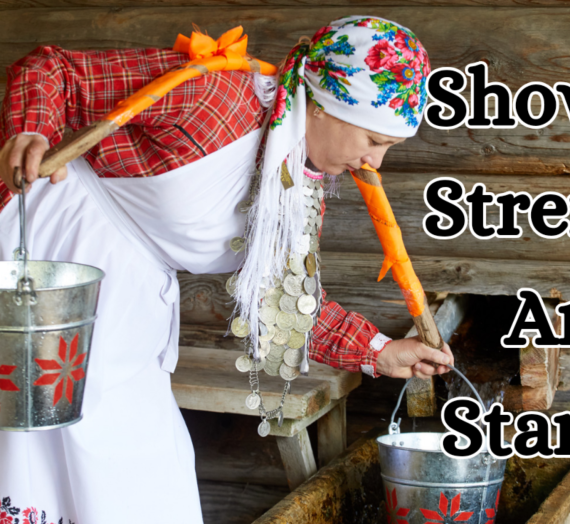Washing laundry by hand is defined as not using a machine to clean your laundry but having to physically do something to make it clean. Many people have washed a single piece of clothing, like this but not an entire load of laundry. Let’s go over what is needed to wash more than a single piece.
Washing can be defined in one of two ways. The first is by removing the dirt, grime, and stains from the garment, cloth, leather, bedding, or whatever needs to be cleaned. The second would be to kill all the germs in the laundry. Both ways will have the soap thoroughly distributed throughout the laundry; then the soap is fully rinsed out.
It might surprise you to learn it was not until 1848 that medical professionals learned that washing hands helped reduce infections. Until then, they believed it was bad humors or smells that caused diseases. If you want to learn more about bad humors, I will leave a link in the show notes.
It was over 20 years later when, in 1876, scientists “found” bacteria for the first time, kicking off a new era of hygiene.
If you are thinking, “Hey, soap has been around longer than that,” you would be correct! There has been evidence of soap found as far back as ancient Babylon in roughly 2800 BC. Before people realized soap killed germs and bacteria, they washed them in soap to get rid of the dirt, grime, and stains.
The first known soaps were a mix of wood ash and animal fats. (Yes, it really makes a soap that kills germs. I will leave a link in the show notes if you want to learn about the process.) These were used in Egypt and Babylon. During medieval times, soap become known as “the work of the devil.” Some historians believe this led to or at least contributed to the black plague. It was around the 17th century that hygiene started making a comeback.
In ancient civilizations, washing laundry was done at the river. People would dip the laundry into the water, then rub the soap on. Afterward, it would be rubbed on a washboard or rocks, twisted or wrung to get the water out, sometimes beaten on rocks to get the dirt out, and then wrung out repeatedly until all the soap was out of it. Some American pioneers boiled the laundry and then laid it out on a flat surface and beat it with a wooden paddle.
Today we have replaced the pounding and beating with an agitator. This can be many things, as long as the agitation gets the water and soap distributed well through all of the laundry. Also, getting water through the clothing to rinse them is equally important. Agitators can be many things, including ones that look like large toilet plungers but are hard metal or plastic, with swills inside to move the water. These are made to be used in an up-and-down motion. This is the one I have personally used. Ours broken when I was a teen, and while we waited for a new one to be delivered from our order to Lehman’s Non-Electric Catalog, I had to roll my pant legs up, to walk and stomp on them.
I have also seen people use half of a wooden barrel or half of a 55-gallon barrel cut in half the long way. They attach a long scraper with a lever to move it back and forth on the bottom of the barrel. It kind of looks like an ice cream or cookie scoop, the ones that have the lever to scrap it off the scoop. Some Amish communities, but not all, use a wooden paddle as an agitator.
An invention that happened in 1797 and significantly improved how washing was done was the wringer. This is a hand-cranked machine that has two to four rollers. The laundry was placed between the rollers and cranked through. This got rid of about 50% of the water. There were many instances of people getting their fingers injured in this machine. I have heard horror stories of it taking out full arms, but normally it was only a finger that was damaged.
My grandmother once told me that originally they only turned one way and would not go backward. After too many young children lost limbs, someone invited a wringer that could turn backward, so they could get the child out of the machine. Some wringers also had release buttons that would pop the top roller up to release the finger. Have you heard the phrase, getting put through the wringer? This was where it came from.
In Rome, washing laundry was originally a male job. However, during the Middle Ages, laundry became a women’s chore. This lasted up until the washing machine became a common household appliance. In fact, one of the reasons people were unsure about washing machines becoming a common item was because they were seen as a machine that took women’s jobs away. One side argued it took away the jobs of women who washed laundry for a living. The other argued it made it easier to do and saved time, giving the woman more time to work outside the home and not have to come home to do laundry also.
Something I learned is that laundry detergent is not soap. It is actually chemicals that make dirt suspend in water. The agitation of the water moving in the wash is what removes them from the fabric. Some believe the harsh chemicals also help in the breakdown of the fibers.
Washing laundry is a fairly simple process. If using a washtub or other container to wash them, there is a wash stage and two rinsing stages, but more rinsing stages can be added if needed. Sometimes if there is a tough stain, it will be scrubbed with a scrub brush. I once saw an elderly lady use a boar bristle hair brush. When I asked why she was using a hairbrush, she said it was cheaper and better than the newfangled fashion ones. Between the wash, rinse, and then rinse again cycles, each individual piece of clothing will need to be wrung out, whether by hand or with a wringer. If washing at the river, this is done on an individual piece of clothing at a time. You don’t want your laundry floating downriver, but using the moving water can help when rinsing. Also, a single piece of laundry is washed and rinsed until it is clean, and not a specific number of times.
Some things I have learned from personal experience, washing laundry is physically demanding. I know if you haven’t done it, it is surprising to hear, but it is a workout. Another thing is that jean pants are difficult to wring out by hand, especially around the waist and pockets. Cloth diapers will need to be rinsed to get all the yuckies out before washing, and a 10 – 15 minute soak in vinegar water after the final rinse. This will help sterilize them, but also helps get rid of any smells.
Plus, the water temperature can affect you as you wring the laundry out. If the water is cold, it is cold outside, or frankly, the wind is just a few degrees below the air temperature, your hands will be cold. If they are too cold, they will hurt. It feels like a burning sensation. Sometimes you will want to add warm water to the cold to make the water warmer. This can get tedious when you have to boil the water. It takes time for the water to reach boiling, and you will need to start the next pot as soon as you dump your first so that it “might” be done when you are ready for it.
Another thing to consider is that the clothing will need to dry. You will have dripping while drying, but more so if they were hand wrung out. In ancient times, clothing was placed over tree limbs or bushes to dry. I can’t find an exact time when clotheslines were invented, but they were used in medieval times and maybe even before. However, in winter, they can literally freeze outside if it is below freezing. In colder climates, people used inside clothing lines or wooden racks hung from the ceiling to dry the clothing where it was warmer. When we dried clothes in the house, if we had electricity, we placed a fan in the room to decrease the drying time. When our kids were young, we hung several lines in the attic of the house and used these when drying out clothing. In the winter, we just left the door to the attic open to let the heat up. Humidity can impact drying times also, even inside the house.
While washing laundry is a relatively simple process, it can be a bit of a learning curve. However, it is the physical demands of washing for at least 45 minutes and all the winging out of the laundry that will take most people by surprise. Keep in mind that this is for a regular load of today’s laundry. You have to take into account how many people are having laundry done. When I had young kids in cloth diapers, I did about three loads every three days. I had to have several clotheslines because if it was raining, it might take three days for the laundry to fully dry. It could be an all-day project.
Yes, there have been other ways that laundry has been washed in history. Many other things have been used instead of soap, including plant roots, soap nuts, and urine. EW!
Fun fact: Today we have a twofer!
First, It is estimated that 30% of the world’s population will own a washing machine by 2025. That is two years after the time I am recording this.
Second, did you know that for a regular-size load of laundry, you are not supposed to use more than one tablespoon of detergent? For large loads of 12 or more pounds, you need two tablespoons at most. Wish someone had informed me before the repairman did.
What could possibly go wrong:
Likely to go wrong: Your character did not thoroughly rinse out the soap. This will leave the clothing stiff in the unrinsed areas, and if too much soap is left, the clothing will look like it is shedding white flakes.
Likely to go wrong: If your character is new at washing laundry by hand, or they have not done it for a long time, they will be exhausted, like they just had a hard workout, when they get done. Doing laundry this way is a lot more physically demanding than most people realize.
Possible to go wrong: If your character is using a wringer washer, they could get a finger seriously injured in the wringer.
Possible to go wrong: If the water is too cold, your character’s hands will hurt and almost feel like their hands are burning. This can be very dangerous in cold climates or wintertime. It could easily turn into frostbite under the right circumstance.
Unlikely to go wrong: Your character dumped their bag, or laundry basket into the river, and their clothing floated away. While most people would know better, some people would not think about the water current until it was too late.
Unlikely to go wrong: While most of recorded history shows the women who washed laundry for a living helped each other out, it is also possible they could end up fighting or in a bitter rivalry. That sounds like it would be a great romantic tension line, but it would work well for many other purposes.
Improbable but technically still in the realm of possibilities: Someone could end up in a scalding hot tub of wash water. This could be a small child that fell in, the washer themself, or a helpless victim they threw in for tipping them badly. Assuming they tipped back in those days, I actually could not find that answer.
Improbable but technically still in the realm of possibilities: If you are writing one where the character has to beat the laundry, they have a great self-defense weapon. They can beat up bad guys and attacking animals, unless it is a beaver. Bevers were made for biting through wood and would likely be able to bite through the laundry paddle.
Helpful Links to Learn More:
History of germs:
What are humors:
https://www.gavi.org/vaccineswork/funny-science-hippocratic-medicine-and-four-humours
Making Wood Ash and Animal Fats Into Soap:
https://www.tngenweb.org/campbell/hist-bogan/SoapMaking.html
History of Washing Laundry:




